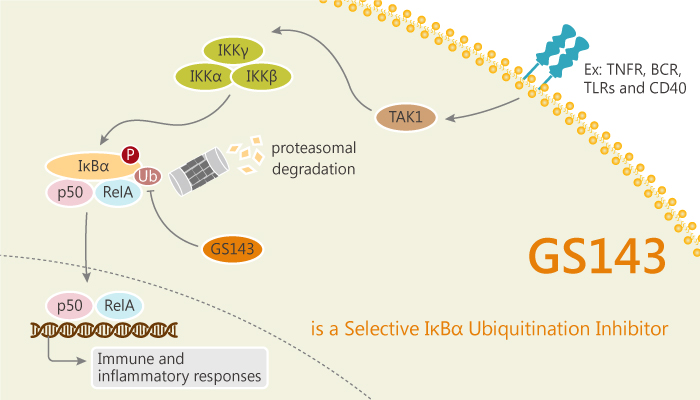GS143 is a selective IκBα ubiquitination inhibitor with an IC50 of 5.2 μM for SCFβTrCP1-mediated IκBα ubiquitylation.

Firstly, when GS143 treatment at different doses in THP-1 cells. GS143 suppresses the transcription of TNFα-induced NF-κB with a mean IC50 value of 10.5 μM. In LPS-activated THP-1 cells, GS143 inhibits the production levels of TNFα and IL-1β with IC50 values of 5.3 μM and 2.1 μM, respectively. However, it does not inhibit p53 and β-catenin expression.
The similar result also exhibits in HT-29 colon cancer cells, this compound inhibits TNFα-induced expression of ICAM-1 with an IC50 value of 6.1 μM.
NF-κB is a heterodimer containing p65 and p50. It always exists in the cytoplasm by its association with the inhibitory molecule, IκB. In the NF-κB signal pathway, inflammatory factors stimulate the activation of IκB kinase (IKK), then it phosphorylates serine residues of IκB protein. The proteolysis of IκB makes NF-κB translocate to the nucleus, NF-κB plays an important role in inducing acute inflammatory responses.
GS143 inhibits the NF-κB signaling. And hence it has the potential to be an anti-inflammatory agent.
Next, in an antigen-induced T helper cell differentiation, GS143 inhibits antigen-induced differentiation of Th2 cells but not of Th1 cells in vitro. Besides, GS143 dose-dependently inhibits the IL-4 production in the Th2-polarizing condition markedly.
Lastly, in vivo, BALB/c mice with antigen-induced allergic inflammation in the airways. GS143 treatment suppresses antigen-induced NF-κB activation in the lung of sensitized mice. It also inhibits antigen-induced eosinophil and lymphocyte recruitment into the airways and the expression of Th2 cytokines and eotaxin in the airways. In a word, GS143 suppresses antigen-induced NF-κB activation in the lung of sensitized mice.
In conclusion, GS143 is a potent IκBα ubiquitination inhibitor with an anti-asthma effect. It suppresses NF-κB activation and transcription of target genes and does not inhibit proteasome activity.
Reference:
[1]. Koichi Hirose, et al. Biochem Biophys Res Commun. 2008 Sep 26;374(3):507-11.
[2]. Hiroto Nakajima, et al. Biochem Biophys Res Commun. 2008 Apr 18;368(4):1007-13.